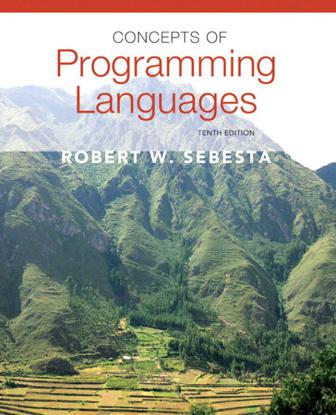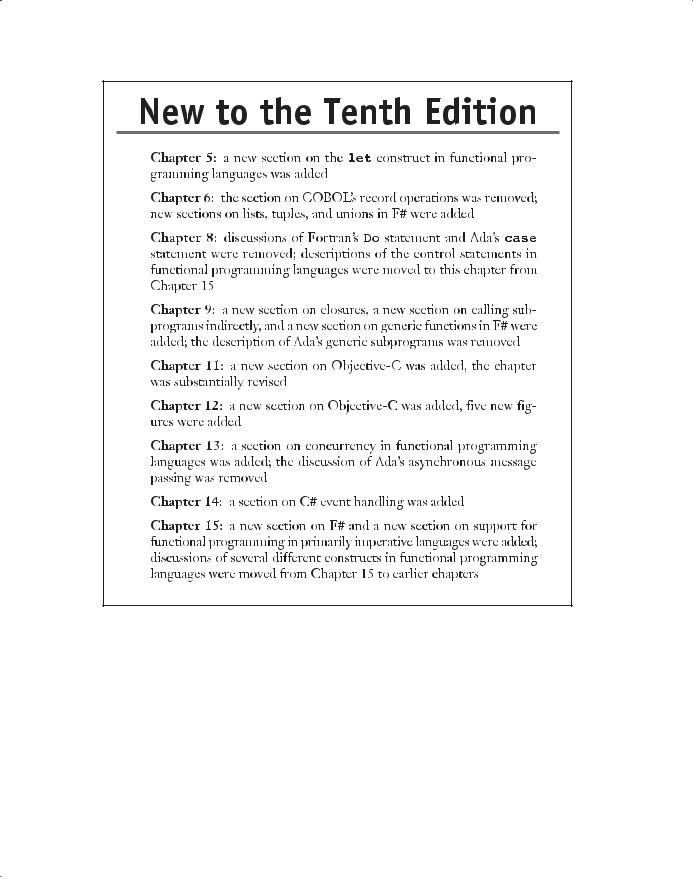
- •New to the Tenth Edition
- •Preface
- •Acknowledgments
- •About the Author
- •Contents
- •1.1 Reasons for Studying Concepts of Programming Languages
- •1.2 Programming Domains
- •1.3 Language Evaluation Criteria
- •1.4 Influences on Language Design
- •1.5 Language Categories
- •1.6 Language Design Trade-Offs
- •1.7 Implementation Methods
- •1.8 Programming Environments
- •Summary
- •Problem Set
- •2.1 Zuse’s Plankalkül
- •2.2 Pseudocodes
- •2.3 The IBM 704 and Fortran
- •2.4 Functional Programming: LISP
- •2.5 The First Step Toward Sophistication: ALGOL 60
- •2.6 Computerizing Business Records: COBOL
- •2.7 The Beginnings of Timesharing: BASIC
- •2.8 Everything for Everybody: PL/I
- •2.9 Two Early Dynamic Languages: APL and SNOBOL
- •2.10 The Beginnings of Data Abstraction: SIMULA 67
- •2.11 Orthogonal Design: ALGOL 68
- •2.12 Some Early Descendants of the ALGOLs
- •2.13 Programming Based on Logic: Prolog
- •2.14 History’s Largest Design Effort: Ada
- •2.15 Object-Oriented Programming: Smalltalk
- •2.16 Combining Imperative and Object-Oriented Features: C++
- •2.17 An Imperative-Based Object-Oriented Language: Java
- •2.18 Scripting Languages
- •2.19 The Flagship .NET Language: C#
- •2.20 Markup/Programming Hybrid Languages
- •Review Questions
- •Problem Set
- •Programming Exercises
- •3.1 Introduction
- •3.2 The General Problem of Describing Syntax
- •3.3 Formal Methods of Describing Syntax
- •3.4 Attribute Grammars
- •3.5 Describing the Meanings of Programs: Dynamic Semantics
- •Bibliographic Notes
- •Problem Set
- •4.1 Introduction
- •4.2 Lexical Analysis
- •4.3 The Parsing Problem
- •4.4 Recursive-Descent Parsing
- •4.5 Bottom-Up Parsing
- •Summary
- •Review Questions
- •Programming Exercises
- •5.1 Introduction
- •5.2 Names
- •5.3 Variables
- •5.4 The Concept of Binding
- •5.5 Scope
- •5.6 Scope and Lifetime
- •5.7 Referencing Environments
- •5.8 Named Constants
- •Review Questions
- •6.1 Introduction
- •6.2 Primitive Data Types
- •6.3 Character String Types
- •6.4 User-Defined Ordinal Types
- •6.5 Array Types
- •6.6 Associative Arrays
- •6.7 Record Types
- •6.8 Tuple Types
- •6.9 List Types
- •6.10 Union Types
- •6.11 Pointer and Reference Types
- •6.12 Type Checking
- •6.13 Strong Typing
- •6.14 Type Equivalence
- •6.15 Theory and Data Types
- •Bibliographic Notes
- •Programming Exercises
- •7.1 Introduction
- •7.2 Arithmetic Expressions
- •7.3 Overloaded Operators
- •7.4 Type Conversions
- •7.5 Relational and Boolean Expressions
- •7.6 Short-Circuit Evaluation
- •7.7 Assignment Statements
- •7.8 Mixed-Mode Assignment
- •Summary
- •Problem Set
- •Programming Exercises
- •8.1 Introduction
- •8.2 Selection Statements
- •8.3 Iterative Statements
- •8.4 Unconditional Branching
- •8.5 Guarded Commands
- •8.6 Conclusions
- •Programming Exercises
- •9.1 Introduction
- •9.2 Fundamentals of Subprograms
- •9.3 Design Issues for Subprograms
- •9.4 Local Referencing Environments
- •9.5 Parameter-Passing Methods
- •9.6 Parameters That Are Subprograms
- •9.7 Calling Subprograms Indirectly
- •9.8 Overloaded Subprograms
- •9.9 Generic Subprograms
- •9.10 Design Issues for Functions
- •9.11 User-Defined Overloaded Operators
- •9.12 Closures
- •9.13 Coroutines
- •Summary
- •Programming Exercises
- •10.1 The General Semantics of Calls and Returns
- •10.2 Implementing “Simple” Subprograms
- •10.3 Implementing Subprograms with Stack-Dynamic Local Variables
- •10.4 Nested Subprograms
- •10.5 Blocks
- •10.6 Implementing Dynamic Scoping
- •Problem Set
- •Programming Exercises
- •11.1 The Concept of Abstraction
- •11.2 Introduction to Data Abstraction
- •11.3 Design Issues for Abstract Data Types
- •11.4 Language Examples
- •11.5 Parameterized Abstract Data Types
- •11.6 Encapsulation Constructs
- •11.7 Naming Encapsulations
- •Summary
- •Review Questions
- •Programming Exercises
- •12.1 Introduction
- •12.2 Object-Oriented Programming
- •12.3 Design Issues for Object-Oriented Languages
- •12.4 Support for Object-Oriented Programming in Smalltalk
- •12.5 Support for Object-Oriented Programming in C++
- •12.6 Support for Object-Oriented Programming in Objective-C
- •12.7 Support for Object-Oriented Programming in Java
- •12.8 Support for Object-Oriented Programming in C#
- •12.9 Support for Object-Oriented Programming in Ada 95
- •12.10 Support for Object-Oriented Programming in Ruby
- •12.11 Implementation of Object-Oriented Constructs
- •Summary
- •Programming Exercises
- •13.1 Introduction
- •13.2 Introduction to Subprogram-Level Concurrency
- •13.3 Semaphores
- •13.4 Monitors
- •13.5 Message Passing
- •13.6 Ada Support for Concurrency
- •13.7 Java Threads
- •13.8 C# Threads
- •13.9 Concurrency in Functional Languages
- •13.10 Statement-Level Concurrency
- •Summary
- •Review Questions
- •Problem Set
- •14.1 Introduction to Exception Handling
- •14.2 Exception Handling in Ada
- •14.3 Exception Handling in C++
- •14.4 Exception Handling in Java
- •14.5 Introduction to Event Handling
- •14.6 Event Handling with Java
- •14.7 Event Handling in C#
- •Review Questions
- •Problem Set
- •15.1 Introduction
- •15.2 Mathematical Functions
- •15.3 Fundamentals of Functional Programming Languages
- •15.4 The First Functional Programming Language: LISP
- •15.5 An Introduction to Scheme
- •15.6 Common LISP
- •15.8 Haskell
- •15.10 Support for Functional Programming in Primarily Imperative Languages
- •15.11 A Comparison of Functional and Imperative Languages
- •Review Questions
- •Problem Set
- •16.1 Introduction
- •16.2 A Brief Introduction to Predicate Calculus
- •16.3 Predicate Calculus and Proving Theorems
- •16.4 An Overview of Logic Programming
- •16.5 The Origins of Prolog
- •16.6 The Basic Elements of Prolog
- •16.7 Deficiencies of Prolog
- •16.8 Applications of Logic Programming
- •Review Questions
- •Programming Exercises
- •Bibliography
- •Index


CONCEPTS OF
PROGRAMMING LANGUAGES
TENTH EDITION
This page intentionally left blank

CONCEPTS OF
PROGRAMMING LANGUAGES
TENTH EDITION
R O B E RT W. S E B E S TA
University of Colorado at Colorado Springs
|
|
|
|
|
|
|
|
|
|
|
Boston Columbus Indianapolis New York |
San Francisco |
Upper Saddle River |
||||||||
Amsterdam |
Cape Town |
Dubai London |
Madrid |
Milan |
Munich |
Paris |
Montreal |
Toronto |
||
Delhi |
Mexico City |
Sao Paulo Sydney |
Hong Kong |
Seoul Singapore |
Taipei |
Tokyo |
||||

Vice President and Editorial Director, ECS: |
Senior Production Project Manager: Marilyn Lloyd |
Marcia Horton |
Manufacturing Manager: Nick Sklitsis |
Editor in Chief: Michael Hirsch |
Operations Specialist: Lisa McDowell |
Executive Editor: Matt Goldstein |
Cover Designer: Anthony Gemmellaro |
Editorial Assistant: Chelsea Kharakozova |
Text Designer: Gillian Hall |
Vice President Marketing: Patrice Jones |
Cover Image: Mountain near Pisac, Peru; |
Marketing Manager: Yez Alayan |
Photo by author |
Marketing Coordinator: Kathryn Ferranti |
Media Editor: Dan Sandin |
Marketing Assistant: Emma Snider |
Full-Service Vendor: Laserwords |
Vice President and Director of Production: |
Project Management: Gillian Hall |
Vince O’Brien |
Printer/Binder: Courier Westford |
Managing Editor: Jeff Holcomb |
Cover Printer: Lehigh-Phoenix Color |
This book was composed in InDesign. Basal font is Janson Text. Display font is ITC Franklin Gothic.
Copyright © 2012, 2010, 2008, 2006, 2004 by Pearson Education, Inc., publishing as Addison-Wesley. All rights reserved. Manufactured in the United States of America. This publication is protected by Copyright, and permission should be obtained from the publisher prior to any prohibited reproduction, storage in a retrieval system, or transmission in any form or by any means, electronic, mechanical, photocopying, recording, or likewise. To obtain permission(s) to use material from this work, please submit a written request to Pearson Education, Inc., Permissions Department, One Lake Street, Upper Saddle River, New Jersey 07458, or you may fax your request to 201-236-3290.
Many of the designations by manufacturers and sellers to distinguish their products are claimed as trademarks. Where those designations appear in this book, and the publisher was aware of a trademark claim, the designations have been printed in initial caps or all caps.
Library of Congress Cataloging-in-Publication Data |
|
Sebesta, Robert W. |
|
Concepts of programming languages / Robert W. Sebesta.—10th ed. |
|
p. cm. |
|
Includes bibliographical references and index. |
|
ISBN 978-0-13-139531-2 (alk. paper) |
|
1. Programming languages (Electronic computers) I. Title. |
|
QA76.7.S43 2009 |
|
005.13—dc22 |
2008055702 |
10 9 8 7 6 5 4 3 2 1
ISBN 10: 0-13-139531-9
ISBN 13: 978-0-13-139531-2

New to the Tenth Edition
 Chapter 5: a new section on the let construct in functional programming languages wasadded
Chapter 5: a new section on the let construct in functional programming languages wasadded
 Chapter 6: the section on COBOL's record operations wasremoved; new sections on lists, tuples, and unions in F# were added
Chapter 6: the section on COBOL's record operations wasremoved; new sections on lists, tuples, and unions in F# were added
 Chapter 8: discussions of Fortran's Do statement and Ada's case statement were removed; descriptions of the control statements in functional programming languages were moved to this chapter from Chapter 15
Chapter 8: discussions of Fortran's Do statement and Ada's case statement were removed; descriptions of the control statements in functional programming languages were moved to this chapter from Chapter 15
 Chapter 9: a new section on closures, a new section on calling subprograms indirectly, and a new section on generic functions in F# were added; the description of Ada's generic subprograms was removed
Chapter 9: a new section on closures, a new section on calling subprograms indirectly, and a new section on generic functions in F# were added; the description of Ada's generic subprograms was removed
 Chapter 11: a new section on Objective-C was added, the chapter was substantially revised
Chapter 11: a new section on Objective-C was added, the chapter was substantially revised
 Chapter 12: a new section on Objective-C was added, five new figures were added
Chapter 12: a new section on Objective-C was added, five new figures were added
 Chapter 13: a section on concurrency in functional programming languages was added; the discussion of Ada's asynchronous message passing was removed
Chapter 13: a section on concurrency in functional programming languages was added; the discussion of Ada's asynchronous message passing was removed
 Chapter 14: a section on C# event handling wasadded
Chapter 14: a section on C# event handling wasadded
 Chapter 15: a new section on F# and a new section on support for functional programming in primarilyimperative languageswere added; discussions of several different constructs in functional programming languages were moved from Chapter 15 to earlier chapters
Chapter 15: a new section on F# and a new section on support for functional programming in primarilyimperative languageswere added; discussions of several different constructs in functional programming languages were moved from Chapter 15 to earlier chapters

Preface
Changes for the Tenth Edition
The goals, overall structure, and approach of this tenth edition of Concepts of Programming Languages remain the same as those of the nine earlier editions. The principal goals are to introduce the main constructs
of contemporary programming languages and to provide the reader with the tools necessary for the critical evaluation of existing and future programming languages. A secondary goal is to prepare the reader for the study of compiler design, by providing an in-depth discussion of programming language structures, presenting a formal method of describing syntax and introducing approaches to lexical and syntatic analysis.
The tenth edition evolved from the ninth through several different kinds of changes. To maintain the currency of the material, some of the discussion of older programming languages has been removed. For example, the description of COBOL’s record operations was removed from Chapter 6 and that of Fortran’s Do statement was removed from Chapter 8. Likewise, the description of Ada’s generic subprograms was removed from Chapter 9 and the discussion of Ada’s asynchronous message passing was removed from Chapter 13.
On the other hand, a section on closures, a section on calling subprograms indirectly, and a section on generic functions in F# were added to Chapter 9; sections on Objective-C were added to Chapters 11 and 12; a section on concurrency in functional programming languages was added to Chapter 13; a section on C# event handling was added to Chapter 14; a section on F# and a section on support for functional programming in primarily imperative languages were added to Chapter 15.
In some cases, material has been moved. For example, several different discussions of constructs in functional programming languages were moved from Chapter 15 to earlier chapters. Among these were the descriptions of the control statements in functional programming languages to Chapter 8 and the lists and list operations of Scheme and ML to Chapter 6. These moves indicate a significant shift in the philosophy of the book—in a sense, the mainstreaming of some of the constructs of functional programming languages. In previous editions, all discussions of functional programming language constructs were segregated in Chapter 15.
Chapters 11, 12, and 15 were substantially revised, with five figures being added to Chapter 12.
Finally, numerous minor changes were made to a large number of sections of the book, primarily to improve clarity.
vi

Preface |
vii |
The Vision
This book describes the fundamental concepts of programming languages by discussing the design issues of the various language constructs, examining the design choices for these constructs in some of the most common languages, and critically comparing design alternatives.
Any serious study of programming languages requires an examination of some related topics, among which are formal methods of describing the syntax and semantics of programming languages, which are covered in Chapter 3. Also, implementation techniques for various language constructs must be considered: Lexical and syntax analysis are discussed in Chapter 4, and implementation of subprogram linkage is covered in Chapter 10. Implementation of some other language constructs is discussed in various other parts of the book.
The following paragraphs outline the contents of the tenth edition.
Chapter Outlines
Chapter 1 begins with a rationale for studying programming languages. It then discusses the criteria used for evaluating programming languages and language constructs. The primary influences on language design, common design tradeoffs, and the basic approaches to implementation are also examined.
Chapter 2 outlines the evolution of most of the important languages discussed in this book. Although no language is described completely, the origins, purposes, and contributions of each are discussed. This historical overview is valuable, because it provides the background necessary to understanding the practical and theoretical basis for contemporary language design. It also motivates further study of language design and evaluation. In addition, because none of the remainder of the book depends on Chapter 2, it can be read on its own, independent of the other chapters.
Chapter 3 describes the primary formal method for describing the syntax of programming language—BNF. This is followed by a description of attribute grammars, which describe both the syntax and static semantics of languages. The difficult task of semantic description is then explored, including brief introductions to the three most common methods: operational, denotational, and axiomatic semantics.
Chapter 4 introduces lexical and syntax analysis. This chapter is targeted to those colleges that no longer require a compiler design course in their curricula. Like Chapter 2, this chapter stands alone and can be read independently of the rest of the book.
Chapters 5 through 14 describe in detail the design issues for the primary constructs of programming languages. In each case, the design choices for several example languages are presented and evaluated. Specifically, Chapter 5 covers the many characteristics of variables, Chapter 6 covers data types, and Chapter 7 explains expressions and assignment statements. Chapter 8 describes control

viii Preface
statements, and Chapters 9 and 10 discuss subprograms and their implementation. Chapter 11 examines data abstraction facilities. Chapter 12 provides an indepth discussion of language features that support object-oriented programming (inheritance and dynamic method binding), Chapter 13 discusses concurrent program units, and Chapter 14 is about exception handling, along with a brief discussion of event handling.
The last two chapters (15 and 16) describe two of the most important alternative programming paradigms: functional programming and logic programming. However, some of the data structures and control constructs of functional programming languages are discussed in Chapters 6 and 8. Chapter 15 presents an introduction to Scheme, including descriptions of some of its primitive functions, special forms, and functional forms, as well as some examples of simple functions written in Scheme. Brief introductions to ML, Haskell, and F# are given to illustrate some different directions in functional language design. Chapter 16 introduces logic programming and the logic programming language, Prolog.
To the Instructor
In the junior-level programming language course at the University of Colorado at Colorado Springs, the book is used as follows: We typically cover Chapters 1 and 3 in detail, and though students find it interesting and beneficial reading, Chapter 2 receives little lecture time due to its lack of hard technical content. Because no material in subsequent chapters depends on Chapter 2, as noted earlier, it can be skipped entirely, and because we require a course in compiler design, Chapter 4 is not covered.
Chapters 5 through 9 should be relatively easy for students with extensive programming experience in C++, Java, or C#. Chapters 10 through 14 are more challenging and require more detailed lectures.
Chapters 15 and 16 are entirely new to most students at the junior level. Ideally, language processors for Scheme and Prolog should be available for students required to learn the material in these chapters. Sufficient material is included to allow students to dabble with some simple programs.
Undergraduate courses will probably not be able to cover all of the material in the last two chapters. Graduate courses, however, should be able to completely discuss the material in those chapters by skipping over parts of the early chapters on imperative languages.
Supplemental Materials
The following supplements are available to all readers of this book at www
.pearsonhighered.com/cssupport.
•A set of lecture note slides. PowerPoint slides are available for each chapter in the book.
•PowerPoint slides containing all the figures in the book.
